
John Ernst Steinbeck was an American writer. He won the 1962 Nobel Prize in Literature "for his realistic and imaginative writings, combining as they do sympathetic humor and keen social perception". He has been called "a giant of American letters."
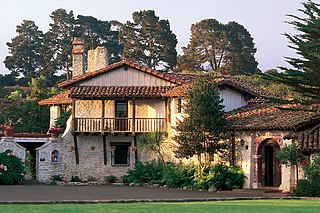
Monterey is a city in Monterey County on the southern edge of Monterey Bay on the U.S. state of California's Central Coast. Founded on June 3, 1770, it functioned as the capital of Alta California under both Spain (1804–1821) and Mexico (1822–1846). During this period, Monterey hosted California's first theater, public building, public library, publicly funded school, printing press, and newspaper. It was originally the only port of entry for all taxable goods in California. In 1846, during the Mexican–American War of 1846–1848, the United States Flag was raised over the Customs House. After Mexico ceded California to the U.S. at the end of the war, Monterey hosted California's first constitutional convention in 1849.

Cannery Row is the waterfront street bordering the city of Pacific Grove, California, but officially in the New Monterey section of Monterey, California. It was the site of a number of now-defunct sardine canning factories. The last cannery closed in 1973. The street name, formerly a nickname for Ocean View Avenue, became official in January 1958 to honor John Steinbeck and his novel Cannery Row. In the novel's opening sentence, Steinbeck described the street as "a poem, a stink, a grating noise, a quality of light, a tone, a habit, a nostalgia, a dream."

In Dubious Battle is a novel by John Steinbeck, written in 1936. The central figure of the story is an activist attempting to organize abused laborers in order to gain fair wages and working conditions.

The Winter of Our Discontent is John Steinbeck's last novel, published in 1961. The title comes from the first two lines of William Shakespeare's Richard III: "Now is the winter of our discontent / Made glorious summer by this sun [or son] of York". It is Steinbeck's only work to entirely take place on the East Coast of the United States; it is primarily set in Sag Harbor, New York.

Tortilla Flat (1935) is an early John Steinbeck novel set in Monterey, California. The novel was the author's first clear critical and commercial success.

Edward Flanders Robb Ricketts was an American marine biologist, ecologist, and philosopher. Renowned as the inspiration for the character Doc in John Steinbeck's 1945 novel Cannery Row, Rickett's professional reputation is rooted in Between Pacific Tides (1939), a pioneering study of intertidal ecology. A friend and mentor of Steinbeck, they collaborated on and co-authored the book, Sea of Cortez (1941).
Bruce Wallace Ariss, Jr. was an American painter, muralist, writer, illustrator, editor as well as theater and set designer, amateur playwright and actor, and overall icon on the Monterey Peninsula, California.

Cannery Row is a 1982 American comedy-drama film directed by David S. Ward in his directorial debut, starring Nick Nolte and Debra Winger. The movie is adapted from John Steinbeck's novels Cannery Row (1945) and Sweet Thursday (1954).

The Slough of Despond is a fictional, deep bog in John Bunyan's allegory The Pilgrim's Progress, into which the protagonist Christian sinks under the weight of his sins and his sense of guilt for them.

Sweet Thursday is a 1954 novel by John Steinbeck. It is a sequel to Cannery Row and set in the years after the end of World War II.
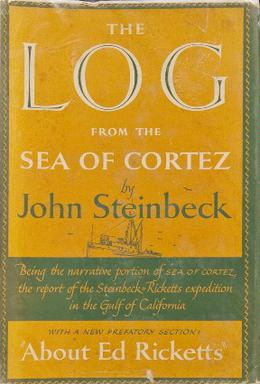
The Log from the Sea of Cortez is an English-language book written by American author John Steinbeck and published in 1951. It details a six-week marine specimen-collecting boat expedition he made in 1940 at various sites in the Gulf of California, with his friend, the marine biologist Ed Ricketts. It is regarded as one of Steinbeck's most important works of non-fiction chiefly because of the involvement of Ricketts, who shaped Steinbeck's thinking and provided the prototype for many of the pivotal characters in his fiction, and the insights it gives into the philosophies of the two men.

Pipe Dream is the seventh musical by the team of Richard Rodgers and Oscar Hammerstein II; it premiered on Broadway on November 30, 1955. The work is based on John Steinbeck's novel Sweet Thursday—Steinbeck wrote the novel, a sequel to Cannery Row, in the hope of having it adapted into a musical. Set in Monterey, California, the musical tells the story of the romance between Doc, a marine biologist, and Suzy, who in the novel is a prostitute; her profession is only alluded to in the stage work. Pipe Dream was not an outright flop but was a financial disaster for Rodgers and Hammerstein.
Joel Walker Hedgpeth was a marine biologist, environmentalist and author. He was an expert on the marine arthropods known as sea spiders (Pycnogonida), and on the seashore plant and animal life of southern and northern California; he co-authored Between Pacific Tides, the definitive guide to California intertidal organisms. He was a spokesperson for care for the floral and faunal diversity of the California coastline.
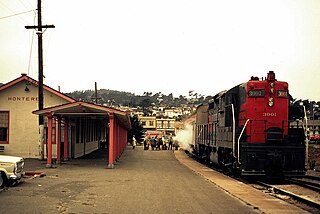
The Del Monte was a passenger train operated by the Southern Pacific Railroad between San Francisco and Monterey, California. It ran from 1889 to 1971.

Pacific Biological Laboratories, abbreviated PBL, was a biological supply house that sold preserved animals and prepared specimen microscope slides, many of which were of maritime aquatic species, to schools, museums, and research institutions. It was located in a building on what is now Monterey's Cannery Row on Monterey Bay in Monterey County, California.
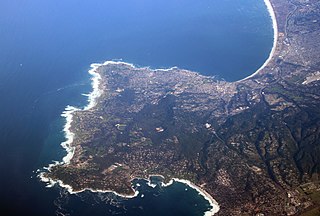
The Monterey Peninsula anchors the northern portion on the Central Coast of California and comprises the cities of Monterey, Carmel, and Pacific Grove, and the resort and community of Pebble Beach.
Walter Kenrick Fisher was an American zoologist, evolutionary biologist, illustrator, and painter. He taught in Stanford University before eventually becoming Emeritus Professor in Zoology until his retirement in 1943. Fisher was the son of ornithologist Albert Kenrick Fisher.
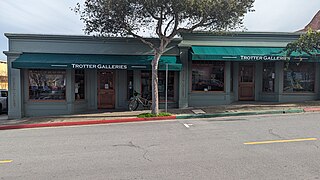
Trotter Museum-Gallery is a museum and art gallery located in Pacific Grove, California, dedicated to preserving and showcasing the artistic and cultural heritage of the Monterey Peninsula region art.
















